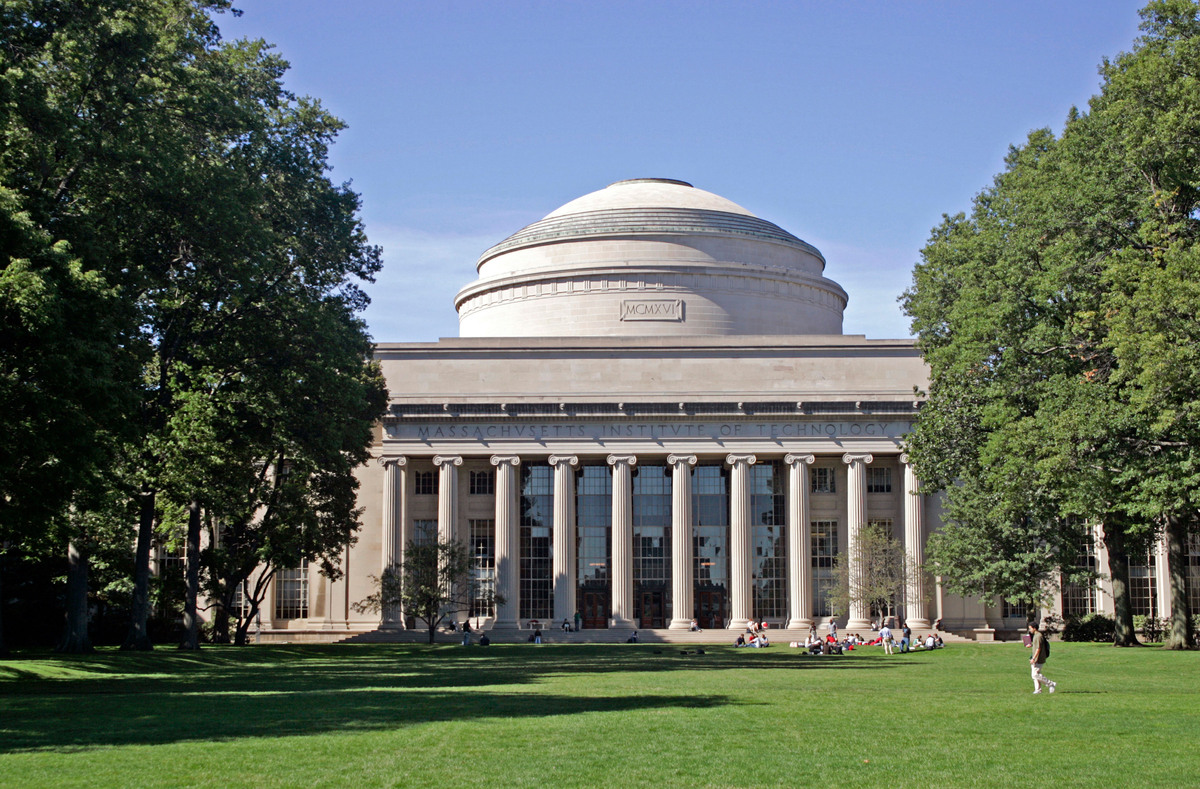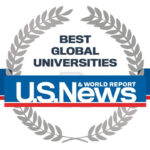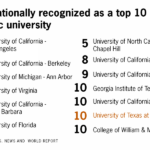Best universities us news and world report – Best Universities: US News & World Report Rankings – a phrase that conjures up images of prestigious institutions, academic excellence, and the ever-present pursuit of higher education. These rankings, released annually by US News & World Report, have become a significant force in shaping the landscape of higher education, influencing the choices of students, the strategies of universities, and even the very definition of what constitutes a “best” university.
The rankings, based on a complex methodology that considers factors like academic reputation, faculty resources, and student outcomes, have become a powerful tool for aspiring students and their families. While the rankings provide a valuable snapshot of institutional performance, it’s important to remember that they are just one piece of the puzzle when it comes to choosing the right university.
US News & World Report Rankings Methodology
The US News & World Report rankings for national universities are based on a comprehensive methodology that considers a wide range of factors, each assigned a specific weight. The methodology aims to provide a holistic view of university quality, encompassing academic reputation, faculty resources, student selectivity, financial resources, graduation rates, and alumni giving.
Methodology for Calculating the National Universities Ranking
The US News & World Report ranking for national universities is calculated using a weighted average of 17 indicators grouped into seven categories. The categories and their respective weights are as follows:
- Outcomes (40%): This category measures the university’s success in producing graduates who are prepared for successful careers and further studies. It includes indicators such as graduation and retention rates, social mobility, and alumni giving.
- Faculty Resources (20%): This category assesses the quality of the university’s faculty, including factors such as faculty salaries, class sizes, and the number of faculty with the highest degrees in their fields.
- Expert Opinion (20%): This category reflects the opinions of academic peers and college presidents on the university’s quality. It is based on a survey of college and university presidents, provosts, and deans.
- Financial Resources (10%): This category measures the university’s financial resources, including factors such as per-student spending, endowment size, and the ratio of students to faculty.
- Student Excellence (7%): This category assesses the academic quality of the student body, including factors such as SAT/ACT scores, high school class rank, and the percentage of students in the top 10% of their high school class.
- Alumni Giving (3%): This category measures the level of support from alumni, which is seen as an indicator of the university’s reputation and the satisfaction of its graduates.
The formula for calculating the overall ranking is:
Overall Score = (Outcome Score x 0.40) + (Faculty Resources Score x 0.20) + (Expert Opinion Score x 0.20) + (Financial Resources Score x 0.10) + (Student Excellence Score x 0.07) + (Alumni Giving Score x 0.03)
Top-Ranked Universities
The US News & World Report rankings are a widely recognized and influential measure of university quality in the United States. The rankings consider a variety of factors, including academic reputation, faculty resources, student selectivity, graduation rates, and financial resources.
National Universities
The National Universities category includes institutions that offer a full range of undergraduate and graduate programs, including doctorate degrees. These institutions are known for their strong research programs and faculty.
| University Name | Rank | Location | Overall Score |
|---|---|---|---|
| Princeton University | 1 | Princeton, NJ | 100 |
| Harvard University | 2 | Cambridge, MA | 99 |
| Columbia University | 3 | New York, NY | 98 |
| MIT | 4 | Cambridge, MA | 97 |
| Yale University | 5 | New Haven, CT | 96 |
| Stanford University | 6 | Stanford, CA | 95 |
| University of Pennsylvania | 7 | Philadelphia, PA | 94 |
| University of Chicago | 8 | Chicago, IL | 93 |
| Johns Hopkins University | 9 | Baltimore, MD | 92 |
| California Institute of Technology | 10 | Pasadena, CA | 91 |
These top-ranked universities are known for their exceptional academic programs, world-renowned faculty, and strong research infrastructure. They attract some of the brightest students from around the world, providing them with a rigorous and stimulating learning environment.
Top-Ranked Universities
The US News & World Report annually publishes rankings for various categories of higher education institutions, including national universities, liberal arts colleges, and regional universities. These rankings are highly regarded and widely used by prospective students, their families, and higher education institutions themselves. The rankings are based on a variety of factors, including academic reputation, student selectivity, faculty resources, financial resources, graduation rates, and alumni giving.
Top-Ranked Liberal Arts Colleges
Liberal arts colleges are institutions that focus on providing a broad-based education in the humanities, social sciences, and natural sciences. They often have smaller class sizes and a more personalized learning environment than larger universities. Here are the top 10 liberal arts colleges in the US News & World Report rankings for 2023:
| College Name | Rank | Location | Overall Score |
|---|---|---|---|
| Williams College | 1 | Williamstown, Massachusetts | 98 |
| Amherst College | 2 | Amherst, Massachusetts | 97 |
| Swarthmore College | 3 | Swarthmore, Pennsylvania | 97 |
| Middlebury College | 4 | Middlebury, Vermont | 96 |
| Pomona College | 5 | Claremont, California | 96 |
| Bowdoin College | 6 | Brunswick, Maine | 95 |
| Wellesley College | 7 | Wellesley, Massachusetts | 95 |
| Carleton College | 8 | Northfield, Minnesota | 95 |
| Claremont McKenna College | 9 | Claremont, California | 94 |
| Davidson College | 10 | Davidson, North Carolina | 94 |
- Williams College is known for its strong emphasis on the humanities and its commitment to undergraduate research. The college offers a wide range of academic programs, including economics, political science, and history, as well as a variety of extracurricular activities, such as theater, music, and athletics.
- Amherst College is another highly selective liberal arts college with a strong reputation for academic excellence. The college is known for its strong faculty, its commitment to undergraduate research, and its beautiful campus.
- Swarthmore College is a Quaker college with a strong commitment to social justice and peace. The college is known for its rigorous academic programs, its strong sense of community, and its beautiful campus.
- Middlebury College is a private liberal arts college known for its strong language programs, its commitment to environmental sustainability, and its beautiful campus in the Green Mountains of Vermont.
- Pomona College is a private liberal arts college known for its strong academic programs, its commitment to undergraduate research, and its beautiful campus in Claremont, California.
- Bowdoin College is a private liberal arts college known for its strong academic programs, its commitment to undergraduate research, and its beautiful campus in Brunswick, Maine.
- Wellesley College is a private women’s liberal arts college known for its strong academic programs, its commitment to social justice, and its beautiful campus in Wellesley, Massachusetts.
- Carleton College is a private liberal arts college known for its strong academic programs, its commitment to undergraduate research, and its beautiful campus in Northfield, Minnesota.
- Claremont McKenna College is a private liberal arts college known for its strong academic programs in economics, government, and international relations, its commitment to undergraduate research, and its beautiful campus in Claremont, California.
- Davidson College is a private liberal arts college known for its strong academic programs, its commitment to undergraduate research, and its beautiful campus in Davidson, North Carolina.
Importance of Rankings for Students

The US News & World Report rankings provide a valuable resource for students researching universities. These rankings can help narrow down the search by providing a snapshot of the academic reputation, resources, and overall quality of different institutions.
Understanding the Rankings’ Value, Best universities us news and world report
The rankings offer a comprehensive overview of various aspects of universities, including academic reputation, faculty resources, student selectivity, graduation rates, and financial resources. They can be particularly helpful for students who:
- Are unsure of their preferred fields of study and want to explore universities with strong programs in various disciplines.
- Are seeking universities with a specific focus on research, teaching, or student life.
- Want to compare universities based on factors like student-faculty ratio, class size, or financial aid opportunities.
Limitations of Rankings
While rankings can be a helpful starting point, relying solely on them for university selection can be misleading. It’s crucial to remember that:
- Rankings are based on specific criteria that may not align with every student’s individual priorities.
- Rankings can be influenced by factors like university size, funding, and geographic location, which may not reflect the overall quality of education.
- Rankings are snapshots in time and may not accurately represent the dynamic nature of higher education institutions.
Using Rankings Effectively
To make informed decisions, students should use rankings in conjunction with other factors, such as:
- Visiting the university campus: Experiencing the campus atmosphere firsthand can provide valuable insights into student life, facilities, and the overall culture.
- Meeting with faculty and current students: Gathering firsthand perspectives from those directly involved in the university community can offer a more comprehensive understanding of the academic experience.
- Researching program-specific rankings: Focusing on rankings for specific fields of study can provide a more accurate assessment of the university’s strengths in that area.
- Considering personal preferences: Students should prioritize factors that align with their individual goals, interests, and learning styles, such as campus size, location, and student support services.
Trends in University Rankings
Over the past decade, US News & World Report university rankings have undergone significant shifts, reflecting evolving priorities in higher education and the increasing influence of data-driven decision-making.
Factors Contributing to Trends
Several factors have contributed to the trends observed in US News & World Report rankings.
- Increased Focus on Research: Universities with strong research programs have consistently risen in the rankings, as US News & World Report places a high value on research output, faculty credentials, and funding. This emphasis has encouraged institutions to prioritize research activities, leading to increased competition for research grants and faculty talent.
- Emphasis on Graduation Rates and Student Outcomes: US News & World Report has increasingly incorporated measures of student success, such as graduation rates and post-graduation employment outcomes, into its rankings. This shift reflects a growing recognition of the importance of preparing students for successful careers and providing a return on investment for their education.
- Growing Importance of Diversity and Inclusion: The rankings have begun to incorporate measures of diversity and inclusion, reflecting a societal shift towards greater equity and representation in higher education. Universities are increasingly focusing on creating more inclusive campus environments and promoting diversity among their student body and faculty.
Potential Implications for the Future of Higher Education
The trends observed in US News & World Report rankings have several potential implications for the future of higher education.
- Increased Pressure on Universities: The rankings create pressure on universities to improve their performance in areas emphasized by US News & World Report. This pressure can lead to increased competition for resources and talent, as well as a focus on strategies that enhance rankings rather than necessarily improving the overall quality of education.
- Potential for Ranking Bias: The reliance on data-driven metrics in the rankings can lead to biases, as certain aspects of university performance may be overemphasized or undervalued. This could result in universities prioritizing specific areas to improve their rankings, even if these areas do not reflect the true value of their programs.
- Impact on Student Choice: The rankings influence student choices, as prospective students often rely on them to guide their decisions. This can lead to a concentration of students at a limited number of top-ranked universities, potentially creating pressure on these institutions and limiting access to higher education for students from diverse backgrounds.
Beyond Rankings
While rankings provide a general overview of universities, they shouldn’t be the sole factor in your decision. Many other crucial aspects contribute to a fulfilling and successful college experience.
Academic Programs
The quality and relevance of academic programs are paramount. Research the specific majors and minors offered, faculty expertise, course offerings, and program accreditation. Consider your interests, career goals, and the reputation of the program within your chosen field.
- For instance, if you are passionate about computer science, look for universities with strong computer science departments, renowned faculty, and state-of-the-art labs.
- Researching program accreditation from organizations like ABET (for engineering) or AACSB (for business) can ensure quality and industry recognition.
Campus Culture
Campus culture encompasses the overall atmosphere, student body, and social environment. Visiting the campus, attending events, and interacting with current students can provide insights into the university’s culture.
- Consider factors like student diversity, campus activities, clubs, organizations, and the overall social scene.
- A vibrant campus culture can enhance your college experience, fostering personal growth and a sense of community.
Location
The university’s location plays a significant role in your overall experience. Consider factors like proximity to your hometown, access to urban amenities, climate, and the surrounding community.
- A university in a bustling city might offer internship opportunities and cultural attractions, while a university in a smaller town might provide a quieter and more focused learning environment.
- Evaluate the availability of public transportation, walkability, and proximity to your desired location.
Financial Aid
College affordability is a major concern. Research the university’s financial aid packages, scholarships, grants, and loan options. Compare different universities’ financial aid packages to determine the most cost-effective option.
- Utilize online resources like the Free Application for Federal Student Aid (FAFSA) and the College Board’s Scholarship Search to explore financial aid opportunities.
- Contact the university’s financial aid office for personalized guidance and assistance.
Regional Rankings: Best Universities Us News And World Report

US News & World Report’s regional rankings offer a more nuanced perspective on university excellence, considering the unique strengths and characteristics of institutions within specific geographic areas. By comparing and contrasting the top-ranked universities in each region, students can gain a better understanding of the academic and extracurricular opportunities available to them, as well as the cultural and social environments that shape their college experience.
Regional Rankings: A Comprehensive Overview
US News & World Report categorizes universities into four major regions: the North, South, Midwest, and West. Each region is further divided into smaller subregions, such as the Northeast, Southeast, and Great Lakes. The rankings within each region are based on a variety of factors, including academic reputation, graduation rates, faculty resources, student selectivity, and financial resources.
Top-Ranked Universities in Each Region
The following tables showcase the top-ranked universities in each of the four major regions, as per the latest US News & World Report rankings.
Northeast
| Rank | University | Location |
|---|---|---|
| 1 | Princeton University | Princeton, NJ |
| 2 | Harvard University | Cambridge, MA |
| 3 | Columbia University | New York, NY |
| 4 | Yale University | New Haven, CT |
| 5 | Massachusetts Institute of Technology (MIT) | Cambridge, MA |
Midwest
| Rank | University | Location |
|---|---|---|
| 1 | University of Chicago | Chicago, IL |
| 2 | Northwestern University | Evanston, IL |
| 3 | University of Michigan-Ann Arbor | Ann Arbor, MI |
| 4 | University of Wisconsin-Madison | Madison, WI |
| 5 | Purdue University | West Lafayette, IN |
South
| Rank | University | Location |
|---|---|---|
| 1 | Duke University | Durham, NC |
| 2 | University of Virginia | Charlottesville, VA |
| 3 | Vanderbilt University | Nashville, TN |
| 4 | University of North Carolina at Chapel Hill | Chapel Hill, NC |
| 5 | Georgia Institute of Technology | Atlanta, GA |
West
| Rank | University | Location |
|---|---|---|
| 1 | Stanford University | Stanford, CA |
| 2 | California Institute of Technology (Caltech) | Pasadena, CA |
| 3 | University of California-Berkeley | Berkeley, CA |
| 4 | University of Southern California (USC) | Los Angeles, CA |
| 5 | University of Washington | Seattle, WA |
Unique Characteristics of Universities in Different Regions
Each region boasts a distinct academic and cultural landscape, shaping the character and offerings of its universities.
Northeast: A Hub of Innovation and Tradition
The Northeast is renowned for its prestigious universities, many of which have long histories and are deeply intertwined with the nation’s intellectual and cultural heritage. Institutions like Harvard, Yale, and Princeton have consistently ranked among the top universities in the world, attracting top scholars and researchers from across the globe.
Midwest: A Blend of Academia and Industry
The Midwest is home to a diverse range of universities, from large public institutions to smaller private colleges. These universities are often known for their strong academic programs in fields like engineering, business, and agriculture, as well as their close ties to the region’s thriving industries.
South: A Growing Center for Research and Development
The South has experienced a surge in university enrollment and research activity in recent years. Institutions like Duke, Vanderbilt, and the University of Virginia have become leading centers for innovation and entrepreneurship, attracting top talent from across the country.
West: A Frontier of Technological Advancement
The West is known for its cutting-edge technology and entrepreneurial spirit, reflected in its universities. Institutions like Stanford, Caltech, and the University of California-Berkeley are at the forefront of scientific discovery and technological innovation, fostering a culture of innovation and collaboration.
The Future of University Rankings
The landscape of university rankings is constantly evolving, influenced by shifts in higher education priorities, technological advancements, and evolving societal values. Predicting the future of rankings requires considering these dynamic factors and their potential impact on the methodologies employed by organizations like US News & World Report.
Impact of Emerging Trends in Higher Education on Ranking Methodologies
Emerging trends in higher education are prompting a re-evaluation of traditional ranking methodologies. These trends are demanding a more nuanced and comprehensive approach to assessing university performance.
- Increased Focus on Student Outcomes: Universities are increasingly being held accountable for the success of their graduates in the job market and beyond. Ranking methodologies may need to incorporate measures of student outcomes, such as employment rates, salaries, and postgraduate studies. For example, a university with a high percentage of graduates who secure jobs in their field of study within a year of graduation might be ranked higher than a university with a lower percentage, even if the latter has higher overall academic scores.
- Growth of Online and Hybrid Learning: The rise of online and hybrid learning models presents challenges for traditional rankings. Universities with robust online programs may not be adequately reflected in rankings that prioritize on-campus experiences. Ranking methodologies may need to evolve to include metrics that assess the quality and effectiveness of online and blended learning.
- Emphasis on Diversity, Equity, and Inclusion: There is a growing emphasis on promoting diversity, equity, and inclusion (DEI) in higher education. Ranking methodologies may need to incorporate measures that reflect a university’s commitment to DEI, such as the representation of underrepresented groups in faculty and student populations, and the availability of support services for diverse learners.
- Focus on Research Impact: The impact of university research is becoming increasingly important. Ranking methodologies may need to consider not only the volume of research output but also its societal impact, such as the number of patents generated, the influence of publications, and the contributions to innovation.
The US News & World Report rankings are a complex and ever-evolving landscape. While they offer a valuable starting point for navigating the world of higher education, it’s essential to approach them with a critical eye, considering a multitude of factors beyond rankings alone. Ultimately, the best university is the one that aligns with your individual goals, aspirations, and learning style.
The US News & World Report rankings are a popular resource for prospective students looking for the best universities, but it’s important to remember that rankings are just one factor to consider. To get a more complete picture of a university, it’s helpful to explore its own news and updates. For instance, you can check out gonzaga university news to learn about their latest achievements, research, and student life.
This kind of information can provide a more nuanced understanding of a university’s strengths and culture, which can be equally valuable as rankings when making a decision about your education.
The U.S. News & World Report rankings are a valuable resource for prospective students, providing insights into the best universities across the country. For those interested in the Northeast, the University of Massachusetts Amherst often features prominently in these rankings. To stay up-to-date on the latest news and developments at UMass Amherst, check out university of massachusetts amherst news.
Ultimately, the best university for you depends on your individual needs and preferences, but the U.S. News & World Report rankings can be a helpful starting point in your search.




